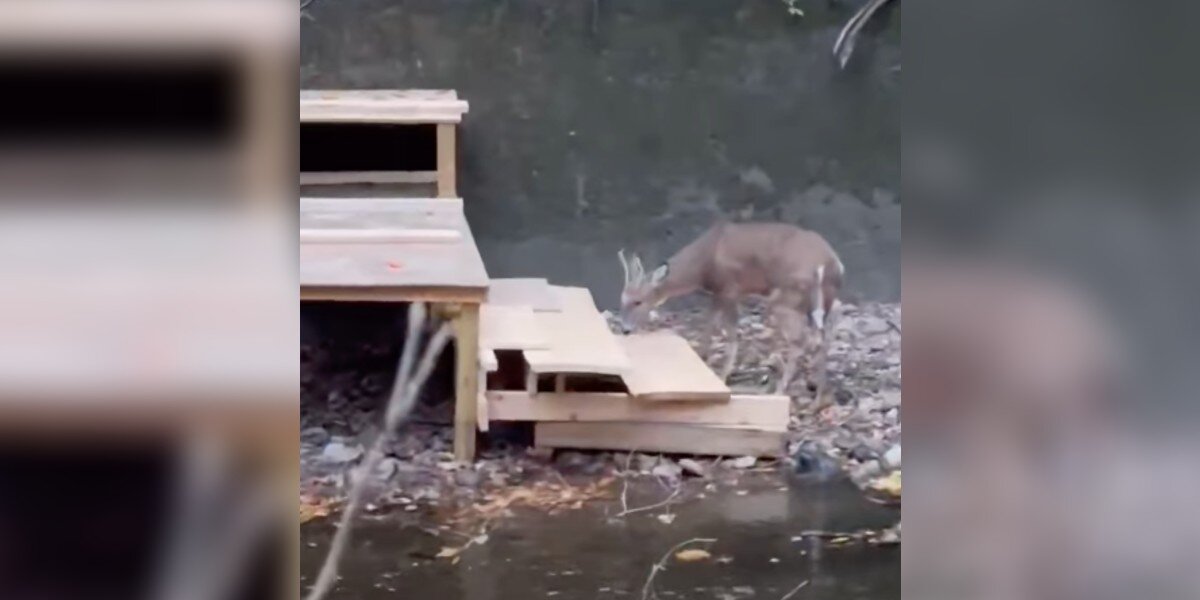A few weeks ago, a herd of deer wandered through a forest in New Jersey. A river runs through a ravine in those woods, with tall cement walls on either side to contain the water. As the herd grazed, one deer either lost his footing or got spooked and tumbled into the ravine.
 The Last Resort Wildlife Refuge
The Last Resort Wildlife Refuge
Injured and alone, the deer had no way to escape. The cement walls were between 7 and 10 feet tall and went on for miles. His only option was to wait.
Finally, after two weeks, local residents called animal control. Officers surveyed the scene and realized they couldn’t handle this type of rescue. They contacted Nancy Warner, president and founder of The Last Resort Wildlife Refuge, for help.
“We walked two miles in each direction and could not find an exit point to guide him to,” Warner told The Dodo. “So, we realized he’s going to have to come up and out.”
 The Last Resort Wildlife Refuge
The Last Resort Wildlife Refuge
Warner added that the forecast at the time called for storms in the next two days. If they didn’t get the deer out within 48 hours, the river would rise and he would be in even worse trouble.
“His herd was still around,” she said. “They were coming to the side of the wall to visit him regularly … They were bellowing to each other. It was really sad.”
Ideally, the USDA would sedate the deer and lift him out of the ravine. But when representatives from the USDA came out to assess the situation, they decided against it.
The Last Resort Wildlife Refuge isn’t authorized to sedate deer, so Warner, who has 36 years of veterinary medicine and wildlife rehab experience under her belt, got creative.
 The Last Resort Wildlife Refuge
The Last Resort Wildlife Refuge
She enlisted Sandy Platt Mantione, a volunteer and carpenter, to build custom stairs for the deer to climb up and out. Mantione didn’t bat an eye — she was on board.
“We were, you know, racing against daylight and that storm,” Warner said. “We loaded up our trailer with all the wood and the supplies, and we got down there and lowered everything in.”
 The Last Resort Wildlife Refuge
The Last Resort Wildlife Refuge
Surprisingly, the deer did not seem shocked by the humans’ presence. “He knew we were there to help him,” Warner said. “He was actually kind of hanging out and monitoring the whole time.”
 The Last Resort Wildlife Refuge
The Last Resort Wildlife Refuge
As Warner described what to build, Mantione and several other volunteers from Associated Humane Societies Newark got to work.
The stairs had to be wide enough for all four of the deer’s legs, without being too steep given his injury.
 The Last Resort Wildlife Refuge
The Last Resort Wildlife Refuge
“I had her add a couple pieces of trim and placed them specifically in places where I knew he would be able to kick off at the back feet to launch upward,” Warner said.
It took the crew almost three hours to construct the stairs. Then they gathered their gear, strategically placed some food pellets on the steps and left.
The Last Resort Wildlife Refuge
In just a few minutes, the deer approached his brand-new, custom staircase. Sniffing the pellets, he quickly figured out where he needed to go.
 The Last Resort Wildlife Refuge
The Last Resort Wildlife Refuge
Within 15 minutes, he successfully cleared the edge of the ravine and was off, back to his herd.
 The Last Resort Wildlife Refuge
The Last Resort Wildlife Refuge
Warner said the deer’s injury was a minor soft tissue injury, not a fracture. She expects it has almost completely healed by now.
In a Facebook post documenting the entire ordeal, Warner wrote she had no idea if this plan would work.
“But,” she said, “we had to try.”
If you’d like to support The Last Resort Wildlife Refuge, you can donate via their website.  Body Cams Capture Dramatic Moment Officers Remove Tomato Tower From Deer’s NeckThey refused to give up on her.
Body Cams Capture Dramatic Moment Officers Remove Tomato Tower From Deer’s NeckThey refused to give up on her.

